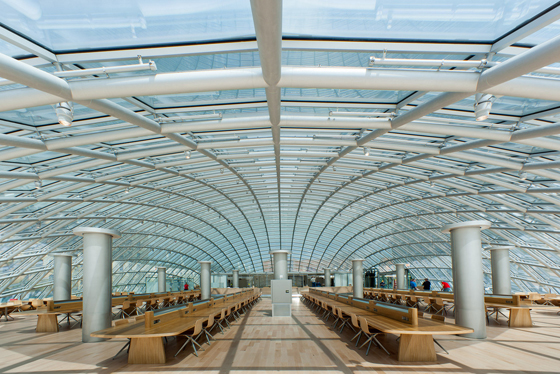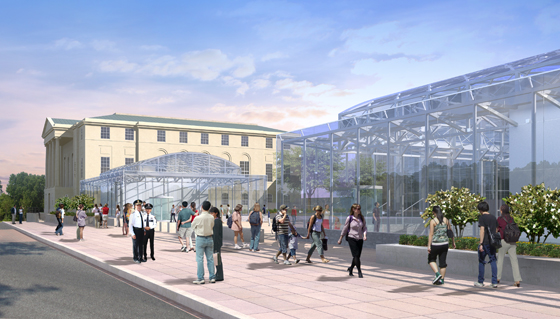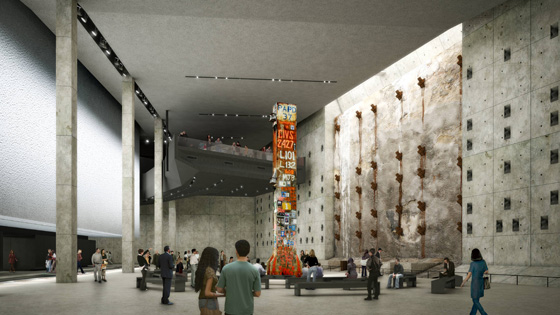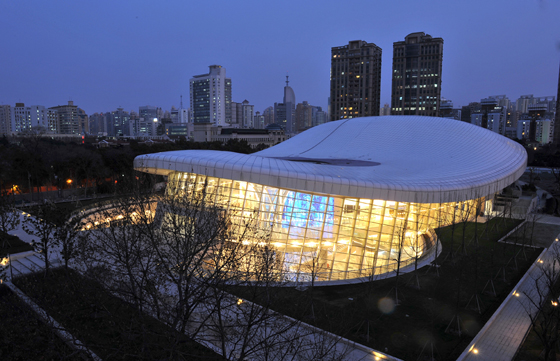Underground Structures
Texto por Tim Abrahams
London, Reino Unido
29.11.11
At the end of the 19th century, HG Wells imagined a future in which industry had been completely located underground, whilst above ground all was green and leafy.Instead, something very different has happened to the building of structures beneath our cities.
The sunlit dome of the Mansueto library. It is immediately adjacent to the Brutalist Regenstein library designed by Skidmore Owings Merrill and completed in 1970

The sunlit dome of the Mansueto library. It is immediately adjacent to the Brutalist Regenstein library designed by Skidmore Owings Merrill and completed in 1970
×In The Time Machine, HG Wells wrote: “there is a tendency to utilize underground space for the less ornamental purposes of civilization.” In that book, Wells imagined a future in which industry had been completely located underground, whilst above ground all was green and leafy. At the end of the 19th century, it was perhaps understandable to imagine a future where this was the case. After all, as Wells put it, referring to the working class areas of London: “Even now, does not an East-end worker live in such artificial conditions as practically to be cut off from the natural surface of the earth?”
The libraries key innovation is its subterranean automated storage and retrieval system, extending 15m underground and which can hold 3.5million volumes

The libraries key innovation is its subterranean automated storage and retrieval system, extending 15m underground and which can hold 3.5million volumes
×Something very different has happened to the building of structures beneath our cities. Certainly Wells was right to identify it as a place modern civilisation would travel to but our cities are free of industry below ground as well as above and whilst we still travel beneath the ground, at the beginning of the 21st century we are also building important cultural facilities there. The phenomenon is particularly pronounced in the USA, although it is becoming increasingly common elsewhere. So why are we putting our theatres, libraries and museums beneath our feet? And how are designers and architects facilitating and making the best of this new trend?
Designed by Helmut Jahn, the Library is effectively an above grade reading room with the book stored beneath. The University of Chicago wanted to keep all its books on campus

Designed by Helmut Jahn, the Library is effectively an above grade reading room with the book stored beneath. The University of Chicago wanted to keep all its books on campus
×The National Law Enforcement Museum (NLEM) in Washington DC is a case in point. Having designed a memorial to the police forces of the United States in Judiciary Square in Washington DC, architect Davis Buckley was charged with subsequently finding a Museum. Wishing to create continuity with the monument, he suggested Judiciary Square itself. Judiciary Square however, is one of the most historical squares in the United States. Pierre L’Enfant, the original planner of the city fought bitterly with George Washington over the laying out of the square, with Thomas Jefferson interceding on his behalf. Abraham Lincoln held his inaugural ball on the site. It has tremendous historic worth.
In architectural terms there is a strong relationship between The Museum of Law Enforcement and Law Enforcement Memorial which sits in the square. Both are designed by Davis Buckley architects

In architectural terms there is a strong relationship between The Museum of Law Enforcement and Law Enforcement Memorial which sits in the square. Both are designed by Davis Buckley architects
×Furthermore Judiciary Square is lined with important buildings and there is only really room underground. The square is home to several specialist courts including the United States Tax Court, the Court of Appeal for the Armed Forces and several courthouses for the District of Columbia. In addition there are number of important government buildings. The square, however, is being refocused away from simply its role as the heart of the US judiciary. It is also becoming an area of museums. The former Pension building is now a museum of architecture called the Museum of Building. The NLEM fits nicely into this dual role of the square.
The entrance pavilion of the Museum of Law Enforcement is set in the historical context of Judiciary Square in Washington DC

The entrance pavilion of the Museum of Law Enforcement is set in the historical context of Judiciary Square in Washington DC
×However there is no room for it to fit nicely into the square! At least, above ground. Davis Buckley’s proposal for the Museum which has just broken ground, is for two 4,000-square foot, above-ground glass-entry pavilions. These are supposed to symbolize the visibility of law enforcement but also provide an unobtrusive entrance on the historic square. The visitor then descends into the Museum, where the space will open to reveal the full expanse of the Museum. Architecturally its not dissimilar to the 9/11 Memorial and Museum albeit that the latter is a response to the ruins of a former building. Still the form is similar, a glass pavilion at ground level, a ramp down, and a vast. (Indeed the NLEM will contain a structural beam collected from Ground Zero.)
Rendering of the low slung roof of the entrance pavilion for the Shanghai Cultural Plaza Theatre, is as much a part of the landscaping as a separate structure

Rendering of the low slung roof of the entrance pavilion for the Shanghai Cultural Plaza Theatre, is as much a part of the landscaping as a separate structure
×According to architect Davis Buckley he’s had to “convince everyone from the National Capital Planning commission to the Secretary of the Interior’ that the subterranean site was the best place for the largest museum in the world dedicated to police. The real reason for submerging the NLEM though is to deal with conservation issues in a historic part of the city. As even young cities like Washington DC age, valuable space is being found underground. They are being made available by the architectural application of the engineering techniques that built what Wells called ‘the less ornamental purposes of civilisation.
A rendering of the Shanghai Cultural Plaza from an aerial view. The entrance pavilion for the Theatre is part of landscape plan dominated by gentle curves

A rendering of the Shanghai Cultural Plaza from an aerial view. The entrance pavilion for the Theatre is part of landscape plan dominated by gentle curves
×The architectural relationship between a glass pavilion and a subterranean store or vault is the primary relationship here. The former has a number of uses: it can provide a means for natural light to pass into lower levels and it can advertise the function of the subterranean structure. This is partially the case with the Joe and Rika Mansueto Library at the University of Chicago which is immediately adjacent to the Regenstein Library - an important brutalist building. The domed reading room, sits modestly next to the Skidmore Owings and Merrill building. Not only is it possible to see what the building is for through the glass structure but conversely when one is inside one can enjoy reading in the natural light. Beneath it a five-storey chamber contains 3.5m books, which are retrieved and delivered to the main desk by one of five massive cranes.
The entrance canopy is a huge space-frame structure which will be colonised by plantlife
So in this new emerging typology we can see an architectural relationship between a glass pavilion which advertises the function and a lower chamber where the cultural delights are stored. We can also see the move underground as being a means of preserving particularly treasured architectural conservation areas - be that a historic downtown or a more recent university campus. We can also see that an architectural language previously reserved for metropolitan transport - small pavilion structures both signaling to and sheltering entrances underground have been expanded and become less incidental, more architectural structures with the use of full glazing. Others existing in the USA: the refurbished underground museum at Franklin Court in Philadelphia; a new underground addition by Frank Gehry to the Philadelphia Museum of Art.
The entrance canopy is a huge space-frame structure which will be colonised by plantlife
It isn’t just the USA though were this subterranean response to sensitive sites is being seen. The Shanghai Culture Plaza is within the former French Concession on a site that previously housed a dog-racing track, then an auditorium for political and cultural events during Mao’s time and, latterly, a central flower market. Its main feature is a theatre which has 570,000 sq m of its full floor space of 650,000m sq m underground thereby making it the largest underground theatre in the world. Although anything generally goes in Shanghai with development, digging down was the only way to get around high limitations in this rare conservation area in the city.Typically for such subterranean structures a sculptural relationship is established in the underground spaces with the entrance above. Here it is a funnel of glass which introduces day light into lower levels of the theatre.
Parts of the 9/11 Memorial Museum are artifacts themselves. The so-called ''slurry wall,'' was built to hold back flood waters of the Hudson.

Parts of the 9/11 Memorial Museum are artifacts themselves. The so-called ''slurry wall,'' was built to hold back flood waters of the Hudson.
×Indeed, ornament is a feature of these expensive buildings, in contradiction to the feature of late 19th Century life that HG Wells noted. The NLEM has a budget of $80m and the Mansueto Library designed by Helmut Jahn, fresh from designing the Veer Towers in Las Vegas, cost $68m to build. These cultural buildings feature highly wrought steel forms, with full glazing in the pavilions above and beneath crowded cities, vast amounts of circulation space - a rare luxury in todays crowded cities. As we turn more of our cities into conservation areas, the underground option for new cultural institutions is becoming more and more attractive.
The west chamber which will house some of the largest artifacts from the twin towers, including the “last column,” removed from the site during a funereal ceremony in 2002. The slurry wall is to the right.

The west chamber which will house some of the largest artifacts from the twin towers, including the “last column,” removed from the site during a funereal ceremony in 2002. The slurry wall is to the right.
×











